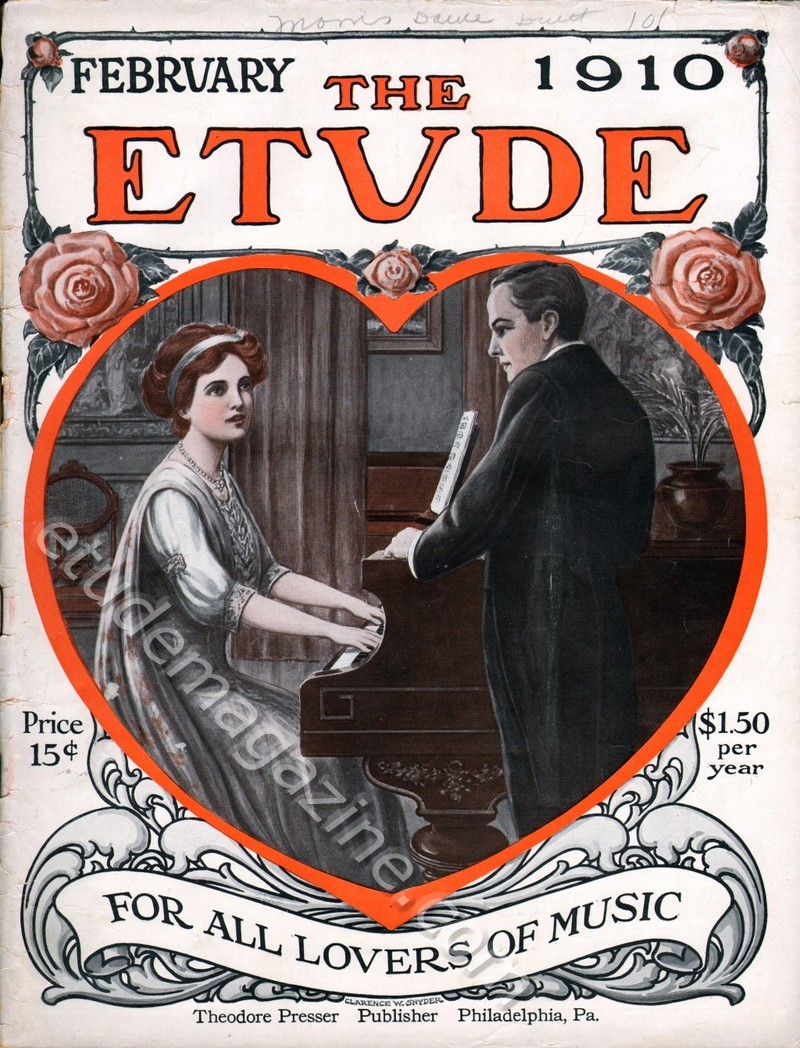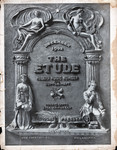February, 1910
Cover art by Clarence W. Snyder.
|
Search eBay for a print copy of the February, 1910 edition of The Etude Music Magazine.
|

Selected Content from the February 1910 Edition of The Etude
The Etude Gallery of Musical Celebrities






The widespread satisfaction which these portrait-biographies have given to our readers during the past year has decided us to continue the feature for another year. The portraits and biographies published during the past year may now be secured in... Read More
Old Traditions and New Ideas, by Mark Hambourg
By Mark Hambourg. Traditions, pedanticisms, yes, I consider them musical chloroforms which deaden the soul and the emotions. But, before saying anything more, I wish to state that if I venture to talk a little about some views… Read More
The Story Of Pepito Arriola
 A representative of The Etude investigated the case of Pepito Arriola with a view to presenting to our readers some interesting educational facts regarding the most astonishing case of precocity known in recent years, with the possible exception of Master Sidis, the child mathematician of Boston. Pepito was born in Madrid on the 14th of December, 1897. A careful investigation of his ancestry reveals that no less than twelve of his forefathers and relations have been pronouncedly musical. His father was a physician and his mother a musician. The child’s early musical training was given to him by his mother, and, as he tells in his own story, was along singularly natural lines.
Read More
A representative of The Etude investigated the case of Pepito Arriola with a view to presenting to our readers some interesting educational facts regarding the most astonishing case of precocity known in recent years, with the possible exception of Master Sidis, the child mathematician of Boston. Pepito was born in Madrid on the 14th of December, 1897. A careful investigation of his ancestry reveals that no less than twelve of his forefathers and relations have been pronouncedly musical. His father was a physician and his mother a musician. The child’s early musical training was given to him by his mother, and, as he tells in his own story, was along singularly natural lines.
Read More
Methods and Customs of the Paris Conservatoire
The following is a continuation of M. Moszkowski’s article in the January Etude but may be read with interest as a separate article. No living composer for the piano is more famous than Moszkowski. In honoring The Etude with the first article he has written in many years we feel that our readers should join with us in making our appreciation more practical by informing as many musical-lovers as possible of this excellent description of the usages at one of the oldest institutions of musical learning in the world. Read More
A Physiologist’s Comments on Piano Playing
It is known that Beethoven, Liszt and Taussig—that wizard of the keyboard—all, at some period or other, contemplated writing piano methods, but hardly got beyond the intention. In their time the physiology of the muscular actions was yet in its infancy. Their projected methods would probably have turned out as unsatisfactorily as those of Hummel, Czerny and the rest. Read More
Puzzle Pictures

These two pictures are re-printed by courtesy of the Philadelphia "Evening Bulletin." They represent musical instruments and we are presenting them to our readers who like to solve puzzles solely for the amusement they find in it. We offer… Read More
World of Music
At Home. It is said that certain high Society people are trying to persuade Congress to appropriate the sum of $5000 for a presidential box at the opera. Gustav Mahler is now engaged in writing his first opera entitled… Read More
Answers to Questions
A department of expert advice for all ETUDE readers. All letters not bearing full name and address of the sender will be destroyed A department of expert advice for all ETUDE readers. All letters not bearing full name… Read More
Great Italian Masters for the Piano
By JAROSLAW DE ZIELINSKI PART II [The first part of this article outlining the development of pianoforte music in Italy appeared in the January special Italian issue of The Etude.] THE WORK OF MASTERS. A modern… Read More
Prodigies and the Gift of Music
 By HENRY T. FINCK [Editor's Note.—Over a year ago Mr. Louis C. Elson wrote an article for The Etude citing some of the dangers surrounding the musical prodigy who is carelessly exploited. In the present article Mr. H…. Read More
By HENRY T. FINCK [Editor's Note.—Over a year ago Mr. Louis C. Elson wrote an article for The Etude citing some of the dangers surrounding the musical prodigy who is carelessly exploited. In the present article Mr. H…. Read More
Recital Programs
Music That Progressive Teachers Have Found Desirable Pupils of Miss Jessie K. Miller. Winter Good-bye (4 hds.), Harthan; Ripples, Paul Lawson; Picnic in the Woods (4 hds.), A. Sartorio; Slumber Song, C. Gurlitt; Two Little Birds, Margaret Martin; Melody (from… Read More
|
|
|










